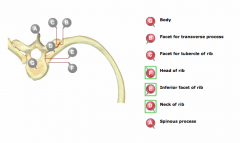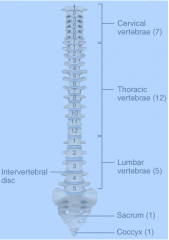![]()
![]()
![]()
Use LEFT and RIGHT arrow keys to navigate between flashcards;
Use UP and DOWN arrow keys to flip the card;
H to show hint;
A reads text to speech;
55 Cards in this Set
- Front
- Back
|
femur
|
long bone
|
|
|
calcaneus
|
heel bone
|
|
|
vertebrae
|
irregular bone
|
|
|
sternum
|
flat bone
articulates directly or indirectly with the cartilages of the second through tenth ribs |
|
|
sesamoid bone
|
small bones found within tendons where there is considerable physical stress
|
|
|
sutural bones
|
can be found b/t certain cranial sutures
|
|
|
foramen
|
opening in a bone which blood vessels and nerves pass
|
|
|
external auditory meatus
|
tube like passageway through a bone
|
|
|
epicondyle
|
prominence above a condyle
|
|
|
orbit (eye socket)
|
optic foramen
superior orbital fissure inferior orbital fissure supraorbital foramen lacrimal fossa sphenoid bone frontal bone maxilla |
|
|
suture
|
an immovable joint
|
|
|
paranasal sinuses
|
cavities within certain cranial and facial bones near the nasal cavity
|
|
|
supraorbital foramen
|
supraorbital nerve and artery
|
|
|
parietal bones
|
sides and roof of the cranial cavity
|
|
|
zygomatic arch
|
zygomatic process of the temporal bone and the temporal process of the zygomatic bone
|
|
|
sagittal suture
|
suture b/t the parietal bones
|
|
|
temporal bone
|
mastoid foramen
styomastoid foramen carotid foramen |
|
|
lambdiodal suture
|
parietal and occipital
|
|
|
styloid process
|
temporal
|
|
|
foramen magnum
|
occipital bone
|
|
|
squamous suture
|
parietal and temporal
|
|
|
anterior fontanel
|
two parietal bones and the two segments of front bones
|
|
|
perpendicular plate
|
ethmoid bone
|
|
|
paranasal sinuses
|
frontal bone
|
|
|
mandible
|
only moveable bone other that the auditory ossicles
has then mental foramen |
|
|
sphenoid bone
|
contains a sinus that is very close to the floor of the brain
greater and lesser wing surrounded by and touched all the other bones on the cranial floor optic foramen travels through |
|
|
occipital bone
|
- articulates with the vertebral column
- inferior and superior nuchal lines, points of attachment for muscle |
|
|
internal auditory meatus
|
temporal bone
|
|
|
fontanels
|
soft sports in the skull filled with fibrous connective tissue which will eventually be replaced by bones
|
|
|
sella turcica
|
located in the sphenoid bone is a depression where the pituitary gland in located
|
|
|
22 bones in the
|
skull
|
|
|
what part of the ethnoid bones forms part of the nasal septum
|
perpendicular plate
|
|
|
maxilla
|
forms part of the hard palate
|
|
|
lacrimal bone
|
contains a duct through which tears from the eyelids drain to the nasal cavity
|
|
|
ethmoid bone
|
have olfactory foramina
|
|
|
anterior fontanel
|
located between the angles of the two parietal bones and the two segments of the frontal bone
|
|
|
hyoid bone
|
supports the tongue and attachment site for muscles of the neck
|
|
|
alveolus
|
a ridge bone marginally protruding from a socket such as those which contain the teeth
|
|
|
vertebra column curves
|
convex cervical and lumbar curves
|
|
|
cervical
|
7 in neck region
|
|
|
thoracic
|
12 are fused
presence of articulating facets on the transverse processes have costal facets long spinous processes |
|
|
large lumbar verebrae
|
5 support lower back
strongest and largest. |
|
|
coccyx
|
4 fused vertebrae found posterior to the thoracic cavity
|
|
|
intervertebral foramina
|
spinal nerves enter and leave the spinal cord
|
|
|
pedicles
|
posterior projections extending directly form the body of a vertebra help form the vertebral foramen
|
|
|
auricular surface
|
articulates with the ilium of the hip bone
|
|
|
vertebral foramen
|
opening b/t vertebral arch and body of a vertebra that houses the spinal cord
|
|
|
atlas and axis
|
cervical vertebrae that lack a body and a spinous process and the axis has an odontoid process
|
|
|
sacrum
|
5 fused vertebrae
|
|
|
thorax
|
ribs, costal cartilages, sternum, bodies of the thoracic vertebrae
1. protect organs or the thoracic and abdominal cavities 2. support of bones of the upper limbs 3. plays a role in breathing |
|
|
tubercle
|
articulates with the transverse process of a vertebrae
|
|
|
xiphoid process
|
a person could damage internal organs if they fracture this during CPR
|
|
|
manubrium of the sternum articulates with
|
the first and second ribs
|
|

name
|
name
|
|

name
|
name
|

